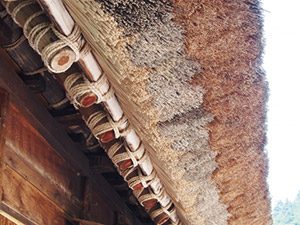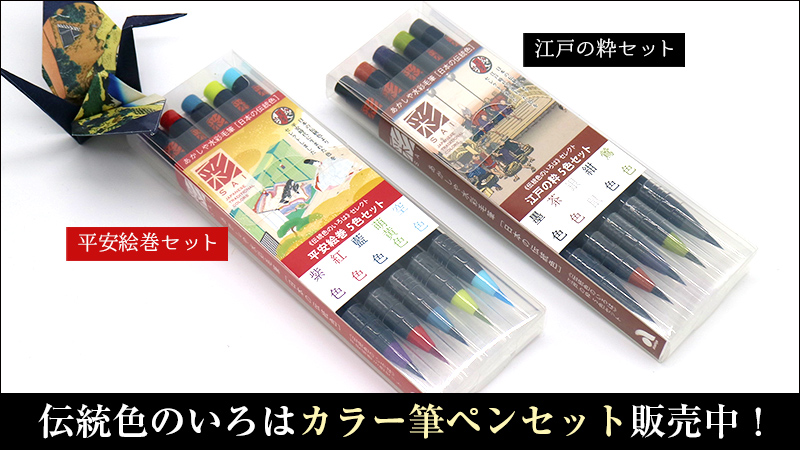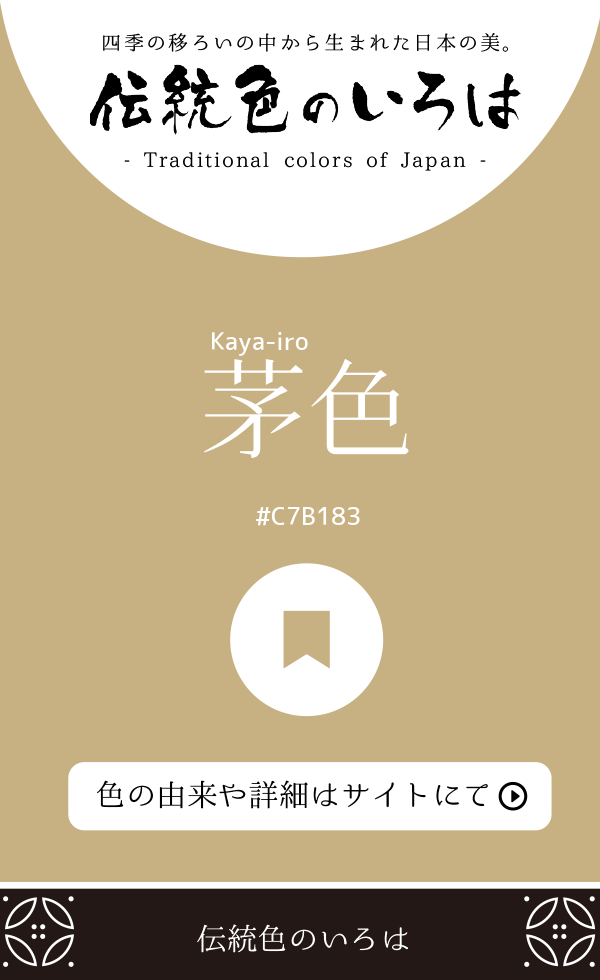| 色の名前Japan Color Name | 茅色(かやいろ) |
|---|---|
| ローマ字Romanized | Kaya-iro |
| RGB | R:199 G:177 B:131 |
| CMYK | C:00 M:15 Y:40 K:30 |
| Web カラーHex triplet | |
| 誕辰色 | 12月4日 |
色の説明
茅色(かやいろ)とは、葺 き替えたばかりの茅葺 き屋根のようなわずかに赤みを帯びたくすんだ黄色のことです。別に『萱色 』の字もあてられ、その名のとおり枯 れた茅に由来する色です。
茅・萱(かや)
茅はススキの別名で、チガヤなどの総称。茅葺屋根につかわれるなど古くから日本人に親しまれた植物で、縄文時代には茅を用いた屋根だけの住居が作られていたようです。
枯れた茅の自然で穏やかな色合いは、秋の情緒を感じさせることから大変好まれ、『万葉集』などに多くの歌が詠まれました。
茅色の他にも枯れた植物に由来する『枯色 』や『枯野 』といった色がありますが、一見、華やかさもないこういった地味な色に美を見出す、日本人の精神性を象徴した色といえるかもしれません。
 茅葺の屋根
茅葺の屋根
-読み:かやいろ-
関連する色の紹介
[Explanation of a color]
Kaya-iro is a yellow color that is slightly reddish like a freshly roofed roof. Separately, the letter "萱 色" is also applied, it is the color derived from the dead Kaya as its name suggests.
Kaya is an alias of Susuki, a generic term for Chigaya et al. It is a plant familiar to Japanese people since ancient times, such as being used for the roof of the roof, in the Jomon period it seems that houses with only the roof using Kaya were made.
The natural and gentle hues of dead Kaya are highly favored from the feeling of autumn emotion, and many songs were written in "Manyoshu" etc.
In addition to Kaya-iro, there are colors such as "Kare-iro" and "Kareno" derived from dead plants, but at first glance there is no ornamentation, finding beauty in such a sober color, the spirituality of the Japanese It can be said that it is a symbolic symbol.
-read: Kaya-iro-
参考書籍
- 長崎盛輝『新版 日本の伝統色 その色名と色調』青幻舎 ISBN-10:4861520711
- 吉岡幸雄『日本の色辞典』紫紅社 ISBN-10:4879405493
- 内田 広由紀『定本 和の色事典』視覚デザイン研究所 ISBN-10:4881082035
注意事項
表示されている色(RGB値)は色の名前に対するおおよそものです。色名によっては広範囲の色を指す場合や文献・書籍等によっては解釈が異なる場合もありますのでご了承ください。 ご利用の環境によっては、色が適切に表示されていない場合があります。
印刷などに伝統色を利用したい場合は、DICグラフィックス株式会社から発売されている日本の伝統色シリーズがオススメです。
Pinterestでシェアする際にご利用ください。
サイト運営者からのお願い
このサイトが気に入った、役に立ったと思われた方は、Amazon・楽天で買い物をする際はぜひ下記のバナーをタップしてからお買い物をお願いいたします。
こちらからお買い物をしていただきますと、価格の1%相当のポイントがサイトに入ります。もちろんその分、高くなるようなことはありません。
いただいたポイントは今後のサイト運営のための書籍代や運営費、モチベーションにつながりますので、ご協力いただけますと嬉しいです。

 DIC 日本の伝統色 第9版
DIC 日本の伝統色 第9版



